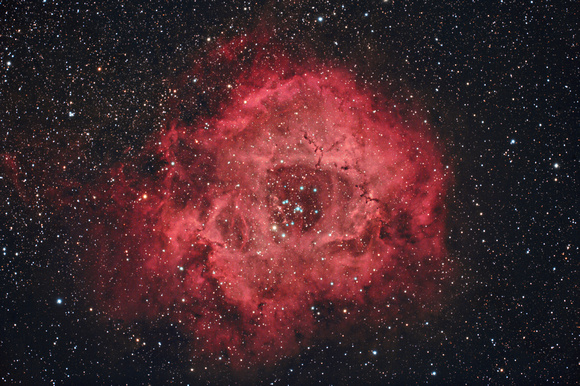RGB:
Canon 350D Hap Griffin Baader Mod
33x360sec at iso 1600
30 Darks/Flats/Bias
Orion ED80 with WO 0.8 reducer/flattener vII
Astronomik 2" CLS Filter
Hydrogen Alpha:
Canon 350D Hap Griffin Baader Mod12x600sec at iso 1600
30 Darks/Flats/Bias
Orion ED80 with WO 0.8 reducer/flattenerBaader 7nm H alpha filter
Combined with a method described by
Russell Croman.
The combined image, besides needing color adjustment, was luminance heavy and thus too opaque. Post processing improved these issues.
Sky and Telescope Online Editor's Choice January 26, 2009The Rosette Nebula is a huge collection of gas and dust residing in an area 1 degree across, or about 5 times the area covered by the full moon. Its parts have been assigned different NGC numbers: 2237, 2238, 2239, and 2246.
Open star cluster NGC 2244 is positioned in the center, consisting of the young stars which recently formed from the nebula's material. After forming about 4 million years ago, the stars began to fuel the nebula's glow by exciting the surrounding gas.
Star formation is ongoing. The cluster is causing the hollow in the center of the nebula with the strong
stellar winds from it's member stars.
The complex is 5,500 light years distant with a diameter of about 130 light years. Mass is estimated at 10,000 to 11,000 solar masses, so it is one of the more massive diffuse nebulae.
This is one of a great number of objects in our galaxy where "
Bok Globules" (named for Dutch astronomer
Bart Jan Bok) can be found. These are small, dark condensations of material which may contain young
protostars.
January 16, 2009


